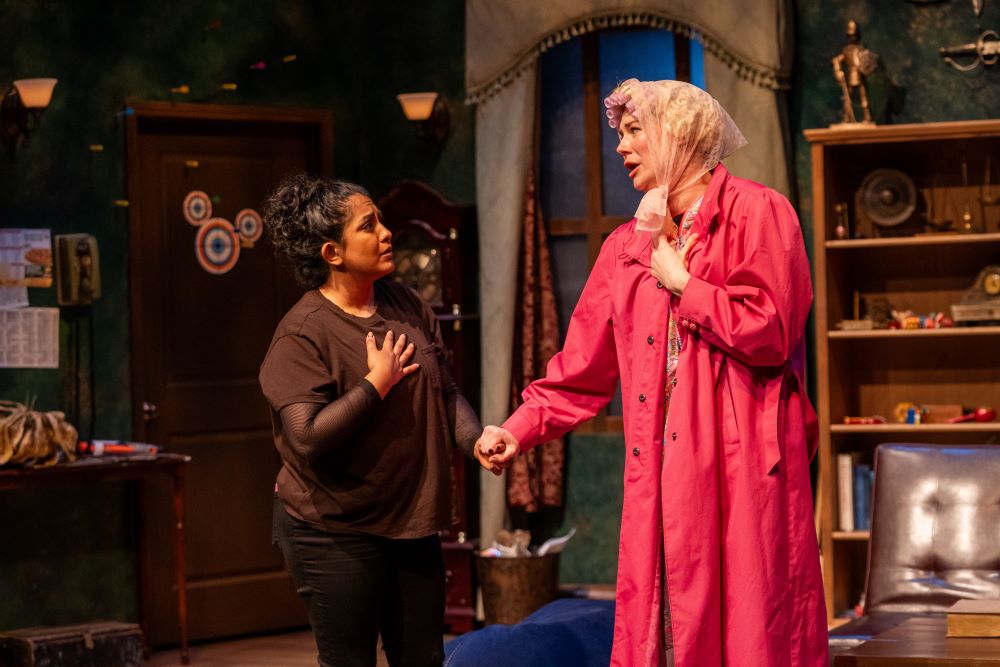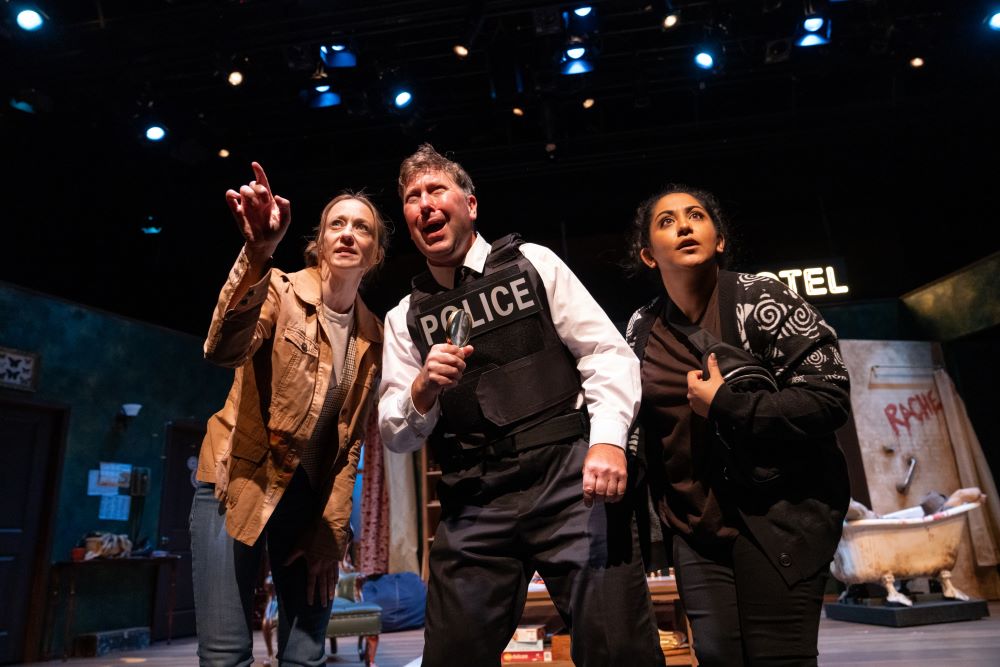Vertigo Theatre’s Canadian premiere of Ms. Holmes & Ms. Watson, adapted by contemporary playwright Kate Hamill, ambitiously reimagines Sir Arthur Conan Doyle’s iconic detective in a post-COVID London setting. The play is a vibrant, genre-bending spoof that breathes new life into the classic Sherlock Holmes narrative by transforming the main characters into women. Amidst rapid-fire deductions, physical comedy, and multiple plotlines, the production is both a refreshing and overwhelming theatrical journey.

Sherlock Holmes, portrayed by the irrepressible Julie Orton, is a buzzing, hyperactive sleuth whose intellectual speed is matched only by her physical energy. Orton’s Sherlock is a whirlwind, constantly in motion, talking as fast as she moves and bouncing off furniture and even walls. Her performance is akin to a humming bee, relentless and frenetic, with an astonishing capacity for deducing complex mysteries at breakneck speed. This characterization provides a lively contrast to the stoic, composed Victorian Holmes we are accustomed to.
Tahirih Vejdani’s portrayal of Joan Watson offers a necessary counterweight to Sherlock’s vivacity. Watson is practical, grounded, and often exasperated by Sherlock’s antics, embodying the archetypal “straight man” to her partner’s chaos. Vejdani’s performance is endearing, and her chemistry with Orton crafts an engaging odd-couple dynamic essential to the play’s humour and emotional balance.
Supporting characters add another layer of humour and complexity to the production. Graham Percy and Camille Pavlenko tackle multiple roles with versatility and playfulness. Percy navigates through characters such as the narrator and the beleaguered Inspector Lestrade with an accent thick as London fog. Pavlenko, on the other hand, delivers winningly unsubtle performances of characters like the frumpy Monk’s wife and the dominatrix Irene Adler. Their performances underscore the play’s slapstick nature, reminiscent of Monty Python and Kids in the Hall sketches.

Director Kathryn Smith’s clever, innovative direction is pivotal in harnessing the play’s frenetic energy. Smith’s wit is evident in the creative and fluid manipulation of the minimalistic set designed by Julia Kim. Furniture and props are continuously rearranged to seamlessly transition between various London locations, such as Holmes and Watson’s flat, a seedy hotel room, and bustling city streets. Smith ensures that even the scene transitions are infused with a sense of levity, contributing to the play’s spirited atmosphere.
The play’s modern setting is not the only element that distinguishes it from traditional Sherlock adaptations. By placing the narrative in a post-pandemic 2021 London, Hamill infuses a contemporary relevance that resonates with today’s audiences. This updated setting also allows for humorous contrasts, such as Sherlock’s disinterest and lack of knowledge about modern technology, much to Watson’s chagrin. These moments of humour are cleverly woven throughout the play, providing both comic relief and a nuanced commentary on the evolution of detective work.

Hamill’s script ambitiously tackles multiple plotlines, leading Sherlock, and Watson through a rapid succession of cases. Among the notable mysteries are the murder of a cabbie, the search for incriminating sex tapes, and the unmasking of a master criminal. Additionally, Sherlock is intrigued by Watson’s personal mystery—why does she insist she is not and has never been a doctor?
Though initially engaging, the complexity of these intertwining plots becomes a double-edged sword. The play feels overextended at almost three hours long, including intermission. The sheer volume of cases dilutes the impact of each mystery, leading to a sense of rushed resolutions and uneven pacing. A more streamlined focus on fewer cases could have maintained the sharpness and vitality evident in the play’s first half.
Despite the structural challenge, the cast’s mastery of physical comedy and slapstick performance is a true highlight. Scenes involving the body in the bathtub and Watson’s entanglements are particularly entertaining, showcasing the actors’ ability to elicit laughter through exaggerated physicality and timing. These moments of high-energy comedy are a testament to the cast’s dedication and Smith’s effective directorial oversight, ensuring the audience is thoroughly entertained.

Hamill’s decision to gender-swap the iconic characters of Holmes and Watson without reducing them to stereotypes introduces a refreshingly feminist perspective.
The arrival of the character Irene Adler, played by Pavlenko, infuses the narrative with sexual tension and verbal sparring that are both cleverly orchestrated and dramatically impactful. Sherlock’s interactions with Adler, juxtaposed with Watson’s obvious disdain for the dominatrix, provide some of the play’s most layered and engaging scenes. This dynamic further delves into the complexities of these women’s relationships and their roles in the modern reimagining of a traditionally male-dominated genre.
Ultimately, Vertigo Theatre’s Ms. Holmes & Ms. Watson offer a lively and inventive homage to Sherlock Holmes. It captures the essence of what makes the world’s greatest detective timeless while injecting new life into the narrative through its gender-swapping and modern-day setting. Despite minor pacing flaws, it promises to leave audiences with much to ponder and plenty to laugh about on their ride home.




